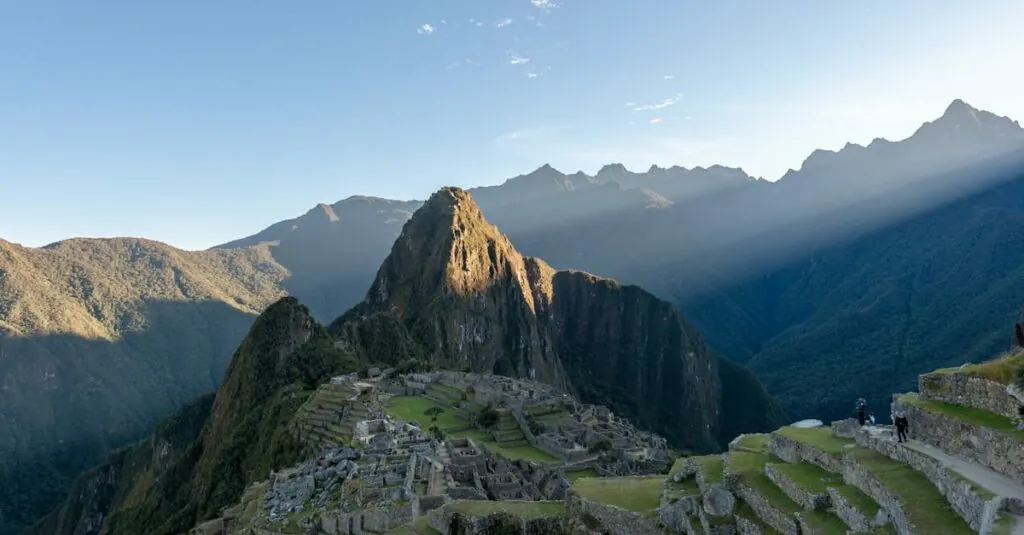Table of Contents
TogglePeru’s culture is a vibrant tapestry woven from ancient traditions, colorful festivals, and mouthwatering cuisine that could make anyone’s taste buds dance. From the majestic Andes mountains to the lush Amazon rainforest, this South American gem boasts a rich history that dates back thousands of years. If you think llamas are just cute animals, wait until you discover their starring role in Peruvian culture!
Overview of Peru Culture
Peru boasts a rich tapestry of cultural elements shaped by its indigenous heritage and historical influences. The Inca Empire profoundly impacts today’s Peruvian society, evident in language, art, and customs. Quechua and Aymara languages remain prominent among various indigenous groups, showcasing linguistic diversity.
Festivals play a vital role in community life. Events like Inti Raymi celebrate the sun god while highlighting traditional music and dance. Unique culinary traditions reflect Peru’s geographical variety, featuring ingredients like potatoes, corn, and quinoa. Peruvian cuisine includes well-known dishes such as ceviche and anticuchos, appealing to locals and tourists alike.
Artisan crafts are prevalent in the country’s cultural expression. Weaving, pottery, and ceramics represent both ancient techniques and modern interpretations. Markets across Peru display vibrant textiles and handmade goods, illustrating the significance of craftsmanship.
Musical traditions also deeply connect to cultural identity. Folk music incorporates traditional instruments like the charango and pan flute, creating sounds unique to Peruvian heritage. Regional styles provide a glimpse into the customs of various communities.
Additionally, religious practices blend indigenous beliefs with Spanish Catholicism, creating a distinct spiritual atmosphere. Pilgrimages to sacred sites showcase the intertwining of ancient rituals with modern faith. This cultural fusion highlights Peru’s ability to maintain tradition while embracing contemporary influences.
Peru’s culture presents a dynamic blend of history, traditions, and innovations that continue to flourish in everyday life.
Traditional Arts and Crafts
Peru’s traditional arts and crafts reflect its rich cultural heritage and craftsmanship. Notable artisans preserve ancient techniques while incorporating modern influences.
Textiles and Weaving
Textiles play a pivotal role in Peruvian culture. Indigenous communities excel in weaving, producing intricate patterns and vibrant colors. Techniques passed down through generations showcase unique designs that often symbolize cultural narratives. Many artisans use natural fibers, such as alpaca and cotton, ensuring high-quality products. Markets in cities like Cusco and Arequipa display these textiles, attracting visitors seeking authentic souvenirs. Besides clothing, textiles serve practical purposes, including home décor and ceremonial items.
Pottery and Ceramics
Pottery in Peru combines functionality with artistic expression. Various regions, such as the Nazca and Moche, have distinct pottery styles that highlight their cultural significance. Craftspeople utilize methods like hand-building and traditional firing techniques, producing both utilitarian and decorative pieces. Some ceramics feature intricate detailing and vibrant glazes, often depicting local wildlife and historical scenes. Workshops in towns like Tigua showcase the artistry behind these creations, directly linking visitors to Peru’s historical narratives through tangible art forms.
Culinary Traditions
Peruvian culinary traditions showcase an extraordinary blend of flavors and techniques influenced by indigenous practices and international styles. These rich traditions create a unique gastronomic experience.
Traditional Dishes
Ceviche stands out as Peru’s iconic dish, consisting of fresh fish marinated in citrus juices. Anticuchos, skewered beef hearts, deliver a savory street food experience beloved by many. Lomo saltado combines stir-fried beef with onions and tomatoes, illustrating Chinese influence in Peruvian cuisine. Aji de gallina features shredded chicken in a creamy chili sauce, offering a rich and comforting flavor. Additionally, causa serves as a cold potato dish layered with avocado and tuna, highlighting the versatility of potatoes in Peruvian cooking. Overall, these traditional dishes exemplify the diverse ingredients and customs that define Peruvian cuisine.
Ingredients and Flavors
Peruvian cuisine thrives on an array of native ingredients. Potatoes, with thousands of varieties grown in the Andes, serve as a staple in many dishes. Corn, another crucial component, appears in forms like hominy or as a base for beverages. Various chili peppers, such as aji amarillo and aji limo, contribute distinctive heat and flavor profiles. Fresh herbs, particularly cilantro, enhance the taste of dishes while adding vibrant colors. Seafood abundance along the coastal regions brings forth freshness in ceviche and other preparations. Collectively, these ingredients deliver the bold and diverse flavors that characterize Peru’s culinary landscape.
Festivals and Celebrations
Peru’s festivals and celebrations reflect its rich cultural heritage and vibrant community spirit. These events highlight the country’s history, traditions, and the blending of indigenous and colonial influences.
Inti Raymi
Inti Raymi, the Festival of the Sun, celebrates the winter solstice in June. This ancient ceremony originated from the Inca Empire, honoring Inti, the sun god. Participants reenact rituals that include music, dancing, and traditional costumes. The event takes place in Cusco, where thousands of locals and tourists gather each year. Engaging performances depict Inca history and religious practices, reinforcing cultural pride. Spectators witness a grand procession at the Sacsayhuamán ruins, capturing the essence of Peru’s indigenous roots.
Dia de los Muertos
Dia de los Muertos, or Day of the Dead, features vibrant customs that honor deceased loved ones. Celebrated on November 1 and 2, this festival merges indigenous beliefs with Catholic traditions. Families create altars adorned with photos, flowers, and food, welcoming spirits back to their homes. In various regions, people gather in cemeteries, illuminating graves with candles and sharing meals. The colorful decorations and lively parades illustrate a profound respect for life and death. This event emphasizes the importance of family and community ties in Peruvian culture.
Social Structure and Family Life
Family forms the cornerstone of Peruvian social structure. In many communities, members prioritize familial relationships, often living together or in close proximity. Daily life reflects a strong emphasis on supporting one another, whether through caregiving, economic cooperation, or emotional support.
Importance of Family
Families in Peru often consist of extended networks that may include grandparents, aunts, uncles, and cousins. Cultural traditions emphasize respect for elders and encourage intergenerational bonding. Frequent gatherings foster closeness, with celebrations centered around birthdays, holidays, and communal feasts. Children play an essential role in family dynamics, learning cultural values from their parents and grandparents. Family ties extend beyond immediate relatives, reinforcing strong connections within the community and ensuring collective well-being.
Community Roles
Community roles in Peru mirror the importance of family life. Individuals engage in various tasks that strengthen social ties, such as participating in local festivals and maintaining communal resources. Elders often assume leadership positions, guiding younger community members and preserving cultural traditions. Women’s roles frequently include managing the household while contributing to local economies through artisan crafts or agricultural activities. Volunteers and local leaders play vital roles in organizing community events, fostering a spirit of cooperation that enhances social cohesion. Through these roles, communities maintain their rich cultural heritage and support one another in daily life.
Music and Dance
Peru’s music and dance embody the country’s vibrant cultural expression. The rich traditions connect to ancestral roots, fusing indigenous sounds with Spanish influences.
Traditional Music Instruments
Traditional music features unique instruments. Charango, a small stringed instrument, showcases Andean heritage. Pan flutes, commonly known as zamponas, create enchanting melodies. Cajón drums provide rhythmic energy found in Afro-Peruvian music. These instruments, among others, play a crucial role in celebratory events, festivals, and daily life, reinforcing cultural identity.
Popular Dance Styles
Numerous dance styles reflect Peru’s multicultural vibe. Marinera stands out with its elegant movements and syncopated footwork, often performed during festival celebrations. Huaylas represents the Andean region, showcasing lively steps that mimic agricultural work. Additionally, Afro-Peruvian dances, like festejo, incorporate rhythm and improvised movements, celebrating African heritage. Each dance style highlights regional flavors and community ties, bringing people together in joyous expression.
Peru’s culture is a captivating tapestry woven from its rich history and diverse traditions. The vibrant festivals and unique culinary experiences reveal a nation that celebrates its heritage while embracing modern influences. From the intricate textiles to the rhythmic music and dance, every aspect of Peruvian culture reflects a deep connection to the land and its people.
As visitors explore this enchanting country, they discover not just the beauty of its landscapes but also the warmth of its communities. The blend of indigenous and colonial influences creates a dynamic cultural landscape that continues to evolve. Engaging with Peru’s traditions offers a profound appreciation for its history and the resilience of its people.




